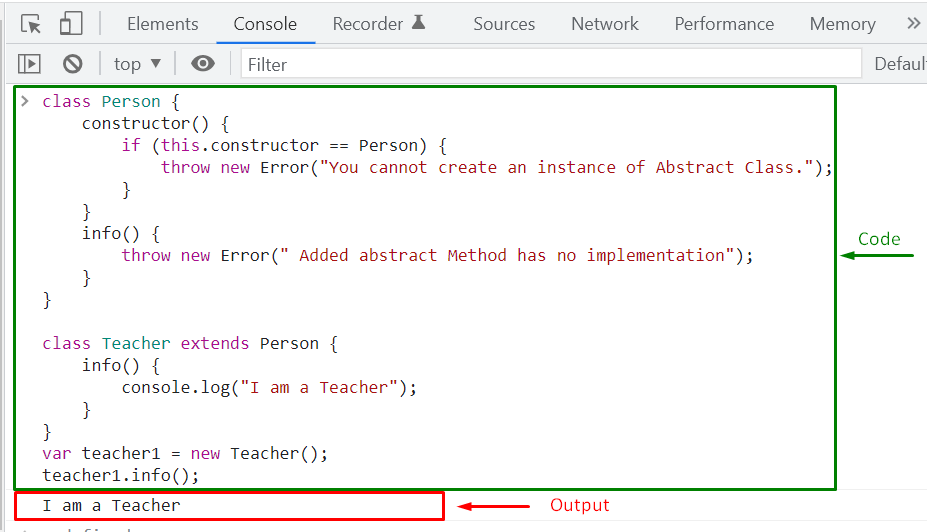The concept of Abstraction in JavaScript is to hide the implementation details and highlight an object’s essential features to the users. That’s how embedding Abstraction in a JavaScript program can enhance the readability of the code and avoid duplication. By providing only important details to the users, it also improves the security of an application.
Don’t know how to implement Abstraction? No worries! This write-up will explain Abstraction in JavaScript with the help of suitable examples. So, let’s start!
Abstract Classes in JavaScript
If a class comprises one or more abstract methods, it is known as an “Abstract Class” and this type of class has abstract as well as regular JavaScript methods. Remember, to implement Abstraction in a class, you have to declare at least one abstract method.
Abstract Methods in JavaScript
In an Abstract class, a type of method that is only declared and has no implementation or “function body” is known as “Abstract Method“. The abstract method must be declared in an Abstract class, whereas its definition can be added in the sub-classes.
We will now demonstrate the procedure for creating an Abstract class.
Example: How to create Abstract Class in JavaScript
First of all, we will create a constructor function named “Person” having a “name” property. The created “Person” function will act as an “Abstract Class”:
this.name = "Alex";
if (this.constructor === Person) {
throw new Error("Your Error Message...");
}
};
In the next step, we will define an “info()” method for the “Person” Abstract class which returns the value of the “name” property:
return this.name;
}
Lastly, we will create a “person” instance of the Abstract Class:
Execution of the provided code will throw an error as we can not create objects or instances of an Abstract class:
Now, we will extend the above-given example by implementing the “Inheritance”. For this purpose, we will create another constructor function that inherits the methods and properties of the “Person” Abstract class.
Example: How to extend Abstract Class in JavaScript
In the same example, we will define a construct function (subclass) named “Teacher” that inherits the properties and methods of the created “Person” class by utilizing the “Prototype Chaining”:
this.name = "Alex";
if (this.constructor === Person) {
throw new Error("Your Error Message...");
}
};
Person.prototype.info = function () {
return "Person name is: " + this.name;
}
function Teacher(name) {
this.name = name;
}
Teacher.prototype = Object.create(Person.prototype);
var teacher1 = new Teacher("Stepheny");
console.log(teacher1.info());
In this case, the implementation of the “Person” Abstract class is hidden, and the “Teacher” Subclass can only access the “info()” method to return the value of the “name” property:
We have tried to implement Abstraction in previous examples; however, all of the properties of an Abstract Class are not completely satisfied; as we have not defined any Abstract methods yet.
The ES6 JavaScript version offers many enhanced features such as creating “Class” using the “class” keyword and implementing methods. It also allows you to define Abstract methods within an Abstract class and extend them in the child or subclasses with the help of “Inheritance”.
In the following example, we will implement a JavaScript Abstract Class having the specified properties.
Example: How to implement Abstraction in JavaScript
By utilizing the “class” keyword, we will now define “Person” as an Abstract class, having a “constructor()”, and an “info()” Abstract method:
constructor() {
if (this.constructor == Person) {
throw new Error("Your Error Message...");
}
}
info() {
throw new Error(" Added abstract Method has no implementation");
}
}
Next, we will create a subclass “Teacher,” which inherits the properties and method of the “Person” class using “Inheritance” and define the implementation of the Parent class abstract method “info()” in the “Teacher” class:
info() {
console.log("I am a Teacher");
}
}
var teacher1 = new Teacher();
teacher1.info();
As you can see, the implementation of the “info()” method is successfully executed:
If the Parent class abstract “info()” method is invoked in the “Teacher” class, it will throw an error. To verify this case, add the following code line in the definition of the child class “info()” method and then again execute the program:
The given output signifies that executing the Abstract method of an Abstract class will throw an Error:
We have compiled all of the essential information related to Abstraction in JavaScript.
Conclusion
Abstraction in JavaScript can be implemented with the help of Abstract Classes and Abstract Methods. In JavaScript, an Abstract class must contain at least one or more declared Abstract methods, whereas its definition can be added in its sub-classes. Abstraction in JavaScript hides the complicated and hard-to-comprehend details of the underlying system. This write-up explained Abstraction in JavaScript along with suitable examples.




